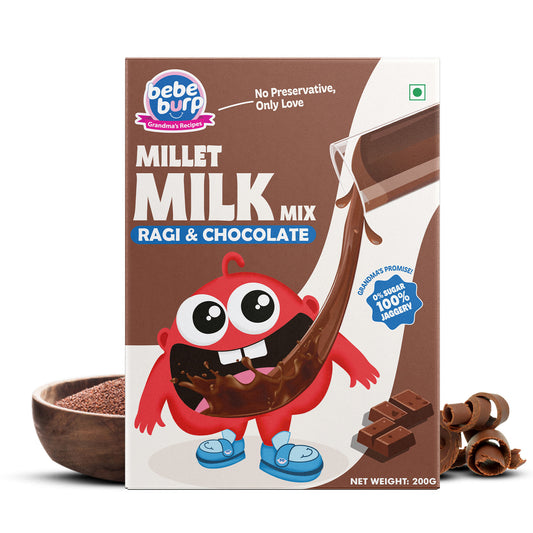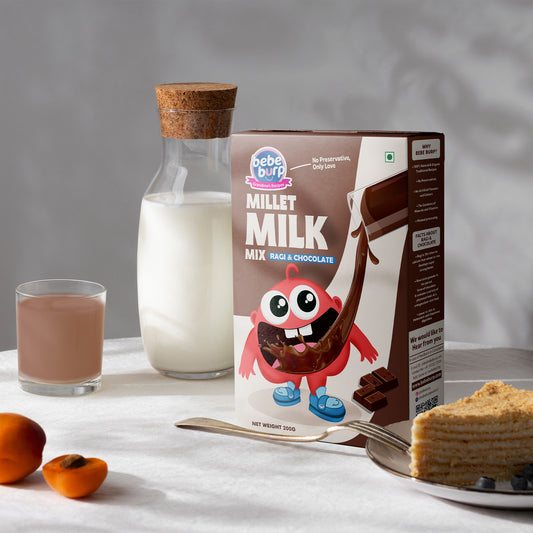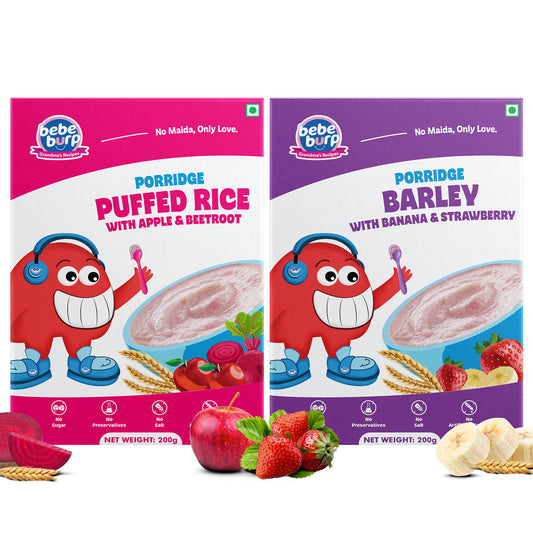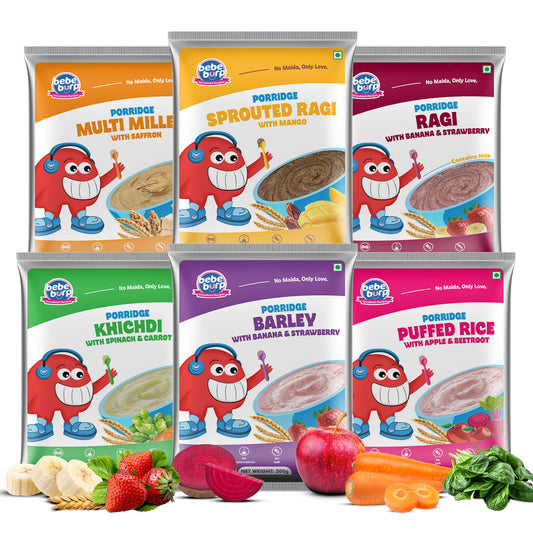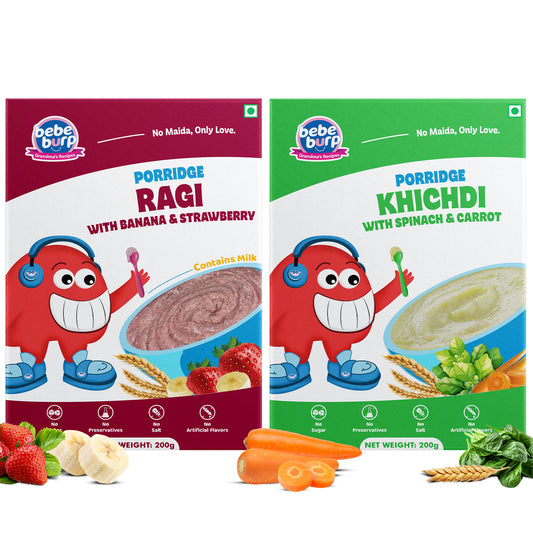Ragi, or finger millet, is an extremely nutritious grain that is normally advised to babies and toddlers due to its abundance in the level of calcium, iron, and fiber. Most parents ask questions on whether mixing ragi with milk is safe and healthy for their little babies.
Although this mixture is a nutritious powerhouse, it is necessary to learn when, how, and what not to do when introducing it to your baby into their diet. This guide will discuss dos and don ts of mixing ragi in milk in terms of safety, health, limitations, and some safe ways of preparing it.
Is It Safe to Mix Ragi with Milk?
Yes--ragi mixed with milk may be safe for most babies, but it is also dependent on the age, digestion and introduction of both foods separately.
-
Babies under 12 months: Cow milk (as a beverage) not before the age 1. But minute amounts may be consumed in the food after 6 months in case the baby does not have an allergy or intolerance to dairy.
-
In the case of toddlers more than 12 months: Ragi and milk are safe to be mixed in the diet of a toddler each day, and there is no dairy allergy.
Babies who are below 1 year can mostly be fed using breast milk or formula. In younger babies, ragi may be added to the breast milk or formula rather than milk.
For a ready-to-use, tasty, and healthy option, check out our Millet Milk Mix – Ragi & Chocolate Health Drink for Kids. Packed with the goodness of ragi and the irresistible taste of chocolate, it’s the easiest way to get your child to love their daily dose of nutrition.
Nutritional Benefits of Ragi and Milk
Ragi (Finger Millet):
- Calcium and bone health: Ragi is one of the calcium-richest sources of plant-based foods (roughly 344 mg 100 g of calcium), and acts as a source of calcium to allow the growth of strong bones and teeth in children.
- Brain Development: Ragi contains plenty of iron, which can prevent blood loss through anemia, maintain efficient blood and brain formation and develop mental health.
- Dietary Fiber: This will enhance digestion, benefit gastrointestinal health, and prevent constipation.
- Protein & Amino Acids: Helps in the development of the muscles and in general body repair; it provides antioxidants which boost immunity.
- Easy to digest: It is naturally gluten-free and does not upset the stomach- suitable even to sensitive stomachs.
Milk:
- Good Protein: Is necessary to build muscles, repair tissues, and most importantly grow.
- Calcium & Vitamin D: Calcium helps keep bone mass and dental welfare, and helps absorb calcium.
- Healthy Fats: Gives us Energy and Develops the Brain during Early Years.
Combined Benefits:
Combining the power of ragi and milk form a balanced meal with nutrition sources that will provide protein, complex carbohydrates, calcium, iron and the requirements essential vitamins in a single helping.
This formula does not only contribute to physical development, but also supports the development of bones, immunity, and cognitive development of a child, which is why it is an outstanding one for a baby and a toddler.
Risks and Precautions
- Antinutrients (Phytates): Ragi has phytates which are antinutrients which can reduce mineral absorption-soaking, fermenting, or sprouting can help to overcome this.
- Digestive upset: Gentleness in introducing ragi is important because consuming it in large amounts or at a high pace may result in constipation or gas.
- Shock-Allergy or Intolerance Reactions: Although unusual, check or rashes on the skin or stomach related uneasiness, particularly at the time of combining with milk.
- Babies should not be given jaggery, sugar or honey (or mixed with milk) before 1 year of age.
How to Mix Ragi with Milk Safely
Babies (6–12 Months)
- Gradually: Begin by using 1/2-2 teaspoons of smooth creamy ragi-milk porridge 1 time a day; as tolerance increases, add 1 teaspoon a day.
- Texture is Important: It should be very thin and mixed up well so that there are no lumps and this will ease digestion.
- Bypass Sweeteners: Do not add jaggery/ sugar/ honey below 1 year.
Toddlers (12+ Months)
- Viscosity Step by Step: You can provide more volume and density and change into thicker gruel or add sweetened pulped fruit such as banana.
- Add Nutrient Boosters: Add ons such as nuts, seeds or grated vegetables can add nutrition.
- Monitor Tolerance: continue to monitor tolerance up to 12 months, including intolerance and digestive distress.
Benefits of Mixing Ragi with Milk
- One Bowl Meal: Ragi offers plant-based calcium, iron, fibre, and amino acids, whereas milk provides healthy protein, vitamin D and healthy fats, making it also a balanced meal that is high on energy.
- Aids in Bone and Teeth Development: Both ragi and milk have high levels of calcium which makes the bones strong, enhances bone density and gives good teeth.
- Encourages Brain Development: Ragi iron and milk-based fat have good fat content, which improves thought capacity and memory among the young generation.
- Supports Gut Health: Fiber in ragi promotes a healthy gut and the milk is warm which makes the dish easy to digest.
- Healthy Weight Gain: It is ideal weight gain food for babies and toddlers who are underweight because it has both calories and essential nutrients that are not heavy on the stomach.
- Boosts Immunity: Ragi contains antioxidants and amino acids and milk contains vitamins to enhance our immune system.
- Kids Stay Full Longer: The complex carbs ragi and the protein in the milk will give them long lasting energy to keep the hunger pangs at bay.
When to Avoid Mixing Ragi with Milk
-
Before 6 Months: The baby should be exclusively breastfed or formula for up to 6 months; solids, such as ragi can be introduced after this time.
-
Cow Milk Before 1 Year: Few children below 12 months should take cow milk in the place of breast milk or formula. In case of milk, small quantities may be used only with the approval of the pediatrician when using milk in ragi recipes.
-
Milk allergy/ lactose intolerance: Skip It you might notice any rashes, diarrhea, bloated, and excessive gas in your baby after drinking milk.
-
When sick or stomach upset: When your kid has fallen ill with diarrhea, constipation or mucus-related sore throats and/or colds, avoid milk-based ragi.
-
Should a Doctor Recommend: Keep an eye on medical advice in times of extra feed intolerances, iron deficiency or food intolerance.
Tip: Water: In case the baby is intolerant to milk, then ragi can also be made with water, breast milk, formula, and other plant-based milk substitutes (which are enriched with calcium and vitamin D).
Conclusion
Mixed with milk, ragi also makes an extremely healthy addition to the diet of your baby or toddler provided it is introduced at the appropriate age and is prepared in a non-toxic manner.
Until 12 months in age babies should have breast milk or formula that should be substituted with cow milk and always look out at allergic reactions whenever introducing new food.
Ragi and milk can make a highly nutritious, satisfying and delicious full-meal that will help your small one in growth and development with proper preparation.


